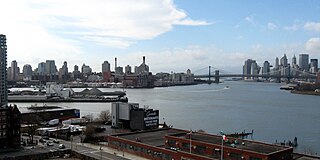| Industry | Banking |
|---|---|
| Founded | April 1, 1824 |
| Headquarters | Brooklyn, New York |
| | This section needs expansion. You can help by adding to it. (February 2020) |
The Long Island Bank was the first bank in Brooklyn, New York.[ citation needed ]
| Industry | Banking |
|---|---|
| Founded | April 1, 1824 |
| Headquarters | Brooklyn, New York |
| | This section needs expansion. You can help by adding to it. (February 2020) |
The Long Island Bank was the first bank in Brooklyn, New York.[ citation needed ]
| | This section needs expansion. You can help by adding to it. (December 2023) |
In the early 1820s, Brooklyn was the 16th largest inhabited place in the United States[ citation needed ]; however, Brooklyn had no bank and no insurance company.
In 1824, the bank was incorporated and became the first bank in Brooklyn.[ citation needed ] The initial capital of the bank was $300,000 in $50 shares. Bank notes were issued from 3 August 1824. [1] [2] Its offices were at 7 Front Street in Brooklyn. The first President was Leffert Lefferts. [1]
In 1867, William S. Herriman, president of the bank, died and was replaced by William C. Fowler. [3]
In 1877 Judge Landon of Schenectedy instructed the Long Island Savings Bank trustees to wind up the affairs of the bank, with payments to start December 14, 1877. [4]

Queens is a borough of New York City, coextensive with Queens County, in the U.S. state of New York. Located at the western end of Long Island, it is the largest of the five New York City boroughs by area. It is bordered by the borough of Brooklyn and by Nassau County to its east, and shares maritime borders with the boroughs of Manhattan, the Bronx, and Staten Island, as well as with New Jersey. Queens is the most linguistically and ethnically diverse place on Earth.

Brooklyn is a borough of New York City. Located on the westernmost end of Long Island, it is coextensive with Kings County in the U.S. state of New York. With 2,736,074 residents as of the 2020 United States census, Kings County is the most populous of the five boroughs of New York City and the most populous county in the State of New York. The population density of Brooklyn was 37,339.9 inhabitants per square mile (14,417.0/km2) in 2022, making it the second-most-densely-populated county in the United States, behind Manhattan, and it had the ninth-highest population of any county nationwide. Were Brooklyn still an independent city, it would be the fourth most populous in the U.S. after the rest of New York City, Los Angeles, and Chicago.

Flatbush is a neighborhood in the New York City borough of Brooklyn. The neighborhood consists of several subsections in central Brooklyn and is generally bounded by Prospect Park to the north, East Flatbush to the east, Midwood to the south, and Kensington and Parkville to the west. The modern neighborhood includes or borders several institutions of note, including Brooklyn College.

Charles Pratt was an American businessman. Pratt was a pioneer of the U.S. petroleum industry, and he established his kerosene refinery Astral Oil Works in Brooklyn, New York. He then lived with his growing family in Clinton Hill, Brooklyn. He recruited Henry H. Rogers into his business, forming Charles Pratt and Company in 1867. Seven years later, Pratt and Rogers agreed to join John D. Rockefeller's Standard Oil.

Abram Stevens Hewitt was an American politician, educator, ironmaking industrialist, and lawyer who was mayor of New York City for two years from 1887 to 1888. He also twice served as a U.S. Congressman from New York's 10th and chaired the Democratic National Committee from 1876 to 1877.

Franklin William Hooper, LL.D. was an American biologist, geologist, educator and institute director.

Wallabout Bay is a small body of water in Upper New York Bay along the northwest shore of the New York City borough of Brooklyn, between the present Williamsburg and Manhattan Bridges. It is located opposite Corlear's Hook in Manhattan, across the East River to the west. Wallabout Bay is now the site of the Brooklyn Navy Yard.

The Kew Gardens station is a station on the Main Line of the Long Island Rail Road (LIRR). It is located in the Kew Gardens neighborhood of Queens, New York City, near Austin Street and Lefferts Boulevard. The station is located within the City Terminal Zone, part of LIRR fare zone 1. It contains four tracks and two side platforms for the outermost tracks.
The Long Island Rail Road is a railroad owned by the Metropolitan Transportation Authority in the U.S. state of New York. It is the oldest United States railroad still operating under its original name and charter. It consolidated several other companies in the late 19th century. The Pennsylvania Railroad owned the Long Island Rail Road for the majority of the 20th century and sold it to the State in 1966.

Long Island has had a long recorded history from the first European settlements in the 17th century to today. Greatly influenced by construction of railroads in the 19th century, it experienced growth in tourism as well as the development of towns and villages into some of the first modern suburbs in the United States.

Robert Troup was a soldier in the Continental Army during the American Revolutionary War and a United States district judge of the United States District Court for the District of New York. He participated in the Battles of Saratoga and was present at the surrender of British General John Burgoyne.
Jacob Holgate was a businessman, member of the Pennsylvania House of Representatives, and served as speaker of the House in 1815.
Kenwood was a hamlet in the Town of Bethlehem, New York. The hamlet spanned both sides of the Normans Kill near the area where the Normans Kill flows into the Hudson River. In 1870, and again in 1910, northern portions of Kenwood were annexed by the City of Albany, New York.
William S. Herriman was a wealthy businessman who became President of Long Island Bank, the first bank in Brooklyn, New York. He remained in that position until his death when he was replaced by William C. Fowler.
Leffert Lefferts was the first President of the Long Island Bank, the first bank in Brooklyn, New York.

Benjamin Douglas Silliman was an American lawyer and politician from New York.

James William Elwell was a 19th-century American businessman and philanthropist. He was well known as one of the oldest shipping merchants in New York having lived in Brooklyn for over forty years. Elwell was the owner of James W. Elwell & Co., a shipping firm at 57 South Street, Manhattan. He was one of the oldest members of the New York Chamber of Commerce. He was known as a philanthropist who helped to found some of Brooklyn's best institutions. Elwell and his wife built the James W. and Lucy S. Elwell House in the national historic district in Clinton Hill, Brooklyn. The pilot boat James W. Elwell was named in his honor.
Henry Parsons Hedges was an American lawyer, politician, and judge from New York.

Queens Directories – of New York City – were, before 1898, an assortment of village directories, Queens County directories, Long Island Directories, and add-ins or partial inclusions to New York City directories. In 1898, 30% of the western part of the old Queens County was absorbed into New York City. Before 1898, Nassau County covered the eastern 70% of the old Queens County. The older, larger Queens County was mostly agricultural, and within it were several towns, villages, and hamlets. In the mid- to late-19th century, cemeteries constituted one of the larger industries in Queens, Kings (Brooklyn), and Westchester Counties. As of 1898, Queens County, New York, and the Borough of Queens, New York City, geographically, have been the same. Both Queens and Brooklyn are on Long Island.

William Williams was an American printer, publisher and bookseller, originally from Massachusetts. He moved to New Hartford, New York, with his family and soon established himself in the printing and newspaper business in nearby Utica, New York during the early nineteenth century. Williams printed the first directory for Utica and published several Utica newspapers and almanacs. Through his various newspapers he published editorials in support of prominent politicians, canal and railroad proposals, and advocated for the colonization of free Blacks. During the War of 1812, he volunteered for military service, organized a company of militia of young men from Utica, and was present during the Second Battle of Sacket's Harbor, where he advanced to the rank of colonel. When a cholera epidemic broke out in Utica in 1832, Williams volunteered in setting up temporary hospitals and aiding the sick and himself became infected. He was an elder and a devoted member of Utica's First Presbyterian Church, and was strongly opposed to Freemasonry, to which he published a controversial newspaper, The Elucidator. Always civic minded, Williams spent the better part of his adult life involved in several areas of public service. In his latter business years he suffered financial difficulties, forcing him to sell off his bookstore and many of his effects. After receiving a serious head injury in a stagecoach accident he endured the last years of his life with a measure of mental impairment.